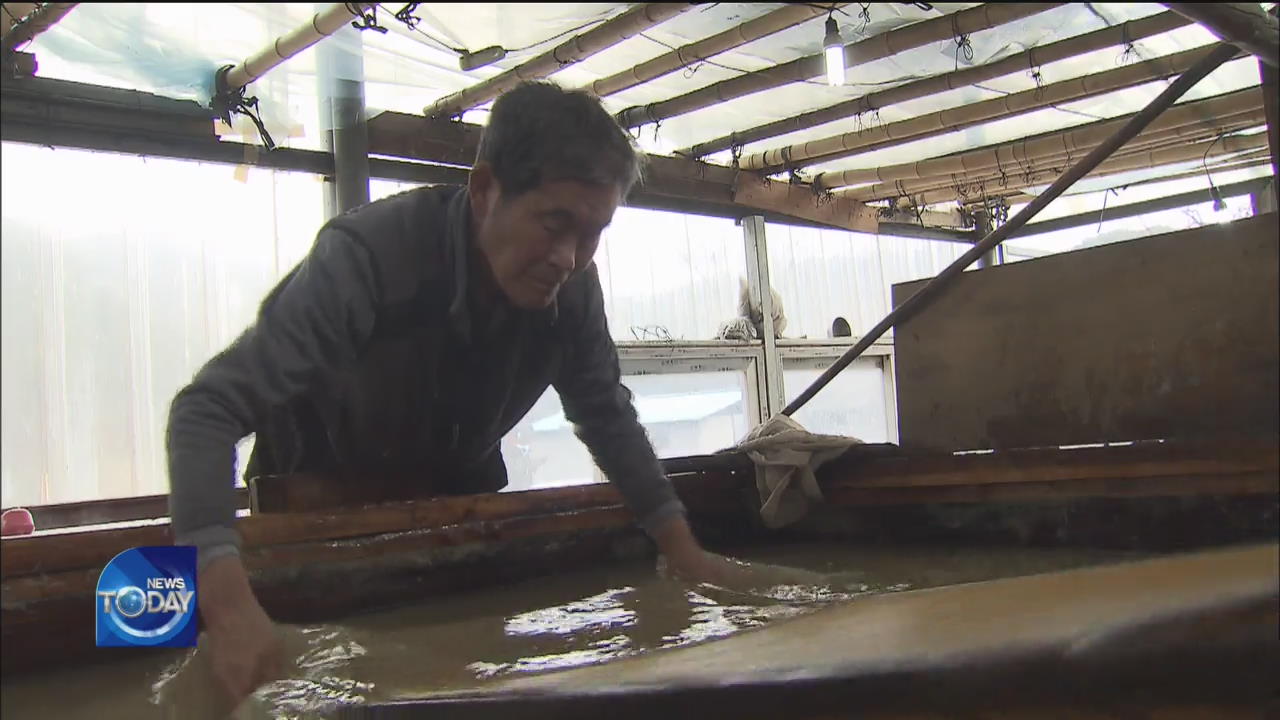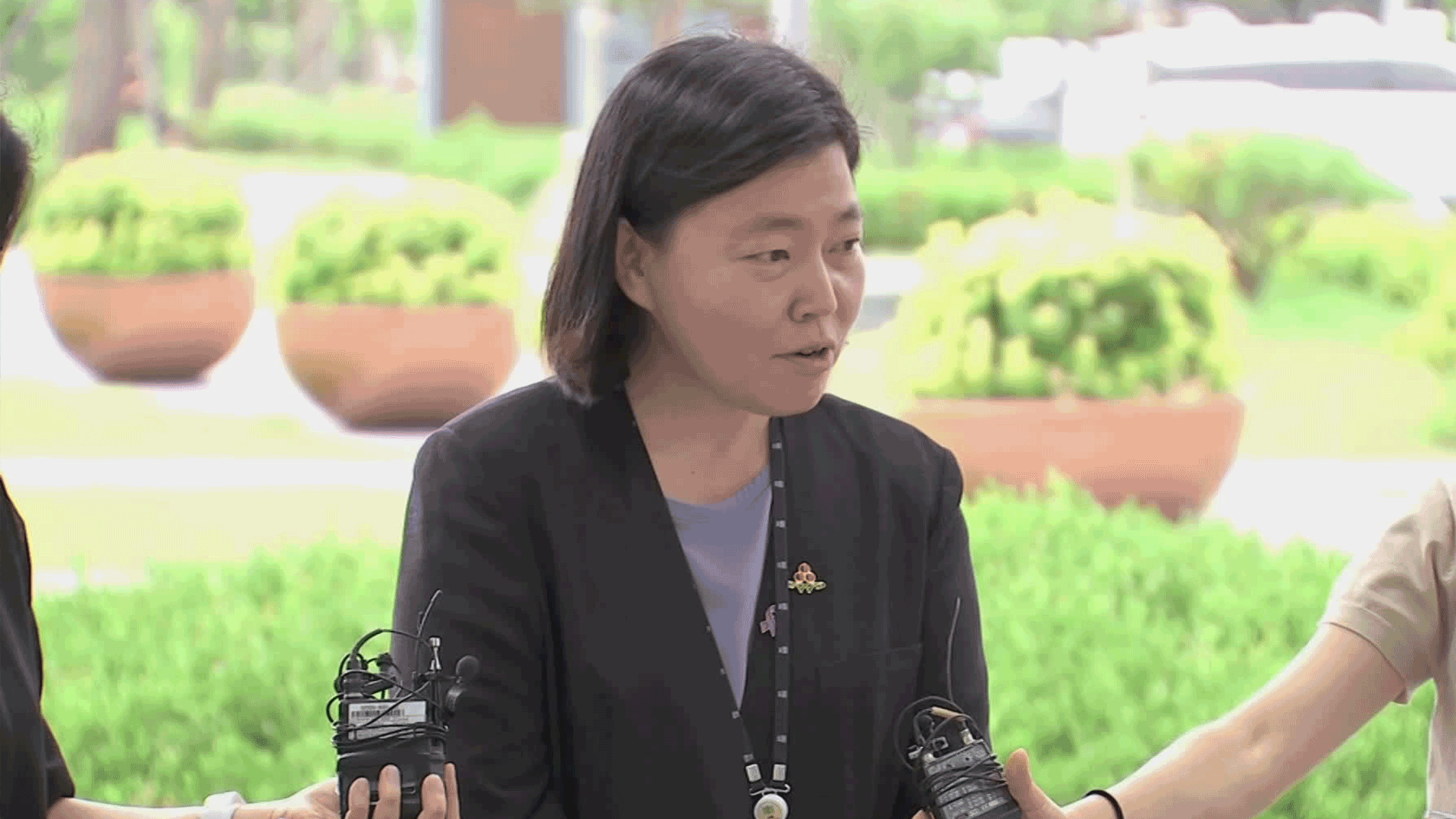LAST REMAINING HANJI WORKSHOP
입력 2020.02.03 (15:06)
수정 2020.02.03 (16:45)
읽어주기 기능은 크롬기반의
브라우저에서만 사용하실 수 있습니다.
[Anchor Lead]
Hanji produced in Jirisan Mountain has a history of over one thousand years that dates back to the Silla Kingdom era. There used to be dozens of workshops producing the traditional Korean paper. Now, only one workshop remains in operation, raising concerns that the thousand-year-old traditional skill could vanish.
[Pkg]
A hanji workshop located in Jirisan Mountain. Mulberry tree bark is boiled in lye all day in one corner of the yard.
[Soundbite] YOON GONG-IM(WIFE OF HANJI MASTER) : "It is tough, strong and very smooth. Boiling in lye makes the fiber very smooth. Anyone can touch it and feel the clear difference from conventional paper. It is really smooth. Producing it can be laborious."
The boiled bark is ground and mixed with paste and water before the master craftsman begins his work. A thin bamboo panel is used to help form sheets of paper. From growing mulberry trees to peeling, boiling and drying their fibrous skin, it's a manual process.
[Soundbite] LEE SANG-OK(HANJI MASTER) : "Few hanji makers grow mulberry trees themselves. Even if they do, it is a small quantity. They use imported trees mostly. I once used imported ones, which were raised in a different climate from Korea but they contained less fiber."
Jirisan hanji boasts a history of over a thousand years, dating back to the Silla dynasty. Around half a century ago, there were more than 40 hanji workshops near the mountain. Today, there is only one. Demand for the traditional paper declined while cheaper Chinese imports dominate the market.
[Soundbite] LEE SANG-OK(HANJI MASTER) : "There are now 19 hanji workshops around the nation. There used to be 24. I made two trips to Seoul for training last year. They are disappearing one after another."
While concerns grow over the uncertain future of Jirisan hanji, the devoted craftsman, steadfastly continues his work, to keep the tradition alive.
Hanji produced in Jirisan Mountain has a history of over one thousand years that dates back to the Silla Kingdom era. There used to be dozens of workshops producing the traditional Korean paper. Now, only one workshop remains in operation, raising concerns that the thousand-year-old traditional skill could vanish.
[Pkg]
A hanji workshop located in Jirisan Mountain. Mulberry tree bark is boiled in lye all day in one corner of the yard.
[Soundbite] YOON GONG-IM(WIFE OF HANJI MASTER) : "It is tough, strong and very smooth. Boiling in lye makes the fiber very smooth. Anyone can touch it and feel the clear difference from conventional paper. It is really smooth. Producing it can be laborious."
The boiled bark is ground and mixed with paste and water before the master craftsman begins his work. A thin bamboo panel is used to help form sheets of paper. From growing mulberry trees to peeling, boiling and drying their fibrous skin, it's a manual process.
[Soundbite] LEE SANG-OK(HANJI MASTER) : "Few hanji makers grow mulberry trees themselves. Even if they do, it is a small quantity. They use imported trees mostly. I once used imported ones, which were raised in a different climate from Korea but they contained less fiber."
Jirisan hanji boasts a history of over a thousand years, dating back to the Silla dynasty. Around half a century ago, there were more than 40 hanji workshops near the mountain. Today, there is only one. Demand for the traditional paper declined while cheaper Chinese imports dominate the market.
[Soundbite] LEE SANG-OK(HANJI MASTER) : "There are now 19 hanji workshops around the nation. There used to be 24. I made two trips to Seoul for training last year. They are disappearing one after another."
While concerns grow over the uncertain future of Jirisan hanji, the devoted craftsman, steadfastly continues his work, to keep the tradition alive.
■ 제보하기
▷ 카카오톡 : 'KBS제보' 검색, 채널 추가
▷ 전화 : 02-781-1234, 4444
▷ 이메일 : kbs1234@kbs.co.kr
▷ 유튜브, 네이버, 카카오에서도 KBS뉴스를 구독해주세요!
- LAST REMAINING HANJI WORKSHOP
-
- 입력 2020-02-03 14:59:03
- 수정2020-02-03 16:45:17

[Anchor Lead]
Hanji produced in Jirisan Mountain has a history of over one thousand years that dates back to the Silla Kingdom era. There used to be dozens of workshops producing the traditional Korean paper. Now, only one workshop remains in operation, raising concerns that the thousand-year-old traditional skill could vanish.
[Pkg]
A hanji workshop located in Jirisan Mountain. Mulberry tree bark is boiled in lye all day in one corner of the yard.
[Soundbite] YOON GONG-IM(WIFE OF HANJI MASTER) : "It is tough, strong and very smooth. Boiling in lye makes the fiber very smooth. Anyone can touch it and feel the clear difference from conventional paper. It is really smooth. Producing it can be laborious."
The boiled bark is ground and mixed with paste and water before the master craftsman begins his work. A thin bamboo panel is used to help form sheets of paper. From growing mulberry trees to peeling, boiling and drying their fibrous skin, it's a manual process.
[Soundbite] LEE SANG-OK(HANJI MASTER) : "Few hanji makers grow mulberry trees themselves. Even if they do, it is a small quantity. They use imported trees mostly. I once used imported ones, which were raised in a different climate from Korea but they contained less fiber."
Jirisan hanji boasts a history of over a thousand years, dating back to the Silla dynasty. Around half a century ago, there were more than 40 hanji workshops near the mountain. Today, there is only one. Demand for the traditional paper declined while cheaper Chinese imports dominate the market.
[Soundbite] LEE SANG-OK(HANJI MASTER) : "There are now 19 hanji workshops around the nation. There used to be 24. I made two trips to Seoul for training last year. They are disappearing one after another."
While concerns grow over the uncertain future of Jirisan hanji, the devoted craftsman, steadfastly continues his work, to keep the tradition alive.
Hanji produced in Jirisan Mountain has a history of over one thousand years that dates back to the Silla Kingdom era. There used to be dozens of workshops producing the traditional Korean paper. Now, only one workshop remains in operation, raising concerns that the thousand-year-old traditional skill could vanish.
[Pkg]
A hanji workshop located in Jirisan Mountain. Mulberry tree bark is boiled in lye all day in one corner of the yard.
[Soundbite] YOON GONG-IM(WIFE OF HANJI MASTER) : "It is tough, strong and very smooth. Boiling in lye makes the fiber very smooth. Anyone can touch it and feel the clear difference from conventional paper. It is really smooth. Producing it can be laborious."
The boiled bark is ground and mixed with paste and water before the master craftsman begins his work. A thin bamboo panel is used to help form sheets of paper. From growing mulberry trees to peeling, boiling and drying their fibrous skin, it's a manual process.
[Soundbite] LEE SANG-OK(HANJI MASTER) : "Few hanji makers grow mulberry trees themselves. Even if they do, it is a small quantity. They use imported trees mostly. I once used imported ones, which were raised in a different climate from Korea but they contained less fiber."
Jirisan hanji boasts a history of over a thousand years, dating back to the Silla dynasty. Around half a century ago, there were more than 40 hanji workshops near the mountain. Today, there is only one. Demand for the traditional paper declined while cheaper Chinese imports dominate the market.
[Soundbite] LEE SANG-OK(HANJI MASTER) : "There are now 19 hanji workshops around the nation. There used to be 24. I made two trips to Seoul for training last year. They are disappearing one after another."
While concerns grow over the uncertain future of Jirisan hanji, the devoted craftsman, steadfastly continues his work, to keep the tradition alive.
이 기사가 좋으셨다면
-
좋아요
0
-
응원해요
0
-
후속 원해요
0

















이 기사에 대한 의견을 남겨주세요.